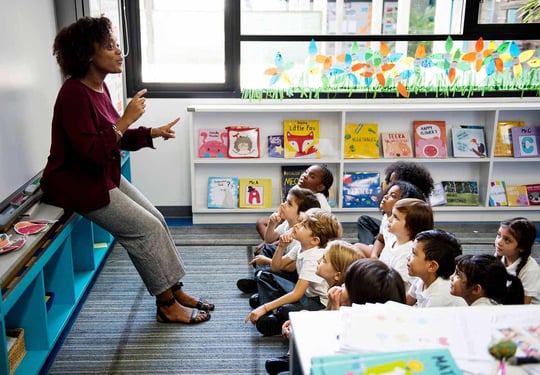6 Empathy Exercises to Try With Students of All Ages
Empathy is the ability to see the world through another person’s eyes and to understand how they feel. Although some people are more naturally empathetic than others, research shows that empathy is a skill, just like math or juggling, that can be taught and learned. The more you practice empathy, the more empathetic you will become.
It’s never too early to start teaching students about empathy. Teaching empathy at school can help reduce bullying at your school, strengthen student-teacher relationships, and create an emotionally safe classroom.
We’ve come up with 6 empathy exercises that you can try with students of all ages. All of these empathy exercises were designed with specific age groups in mind.
But use your discretion; for example, if middle school empathy exercises seem to be a better fit for your 6th graders, then it makes sense to use those (instead of the elementary school lessons). If you teach a group of high schoolers with neurodevelopmental disabilities, then you might choose to use a younger group’s exercises with them.
Empathy Exercises for Elementary School

Elementary school kids come in a wide developmental range, and an empathy lesson that’s appropriate for a 5-year-old kindergartener may not be appropriate for a preteen getting ready to enter middle school.
But, in general, one of the main goals for younger kids is to help them recognize different emotions. Kids at this age are just beginning to be able to label their own feelings. Being able to name their feelings, as well as recognize when they observe those same feelings in someone else, is the start of building empathy.
Acting out feelings
One basic empathy lesson you can use with elementary students is helping them to act out their feelings. Create a list of various emotion words. Even for younger elementary students, expand these words past the basics of “sad,” “mad,” and “happy.” Older elementary students may be able to understand complex emotions like “ashamed” and “satisfied.”
Then, randomly assign each child an emotion, and ask them to “act it out.” They can act the emotions out using their face, or with their whole body. For example, “angry” might look like furrowed brows, but it could also look like crossing their arms.
You can take this exercise one step further by asking the other students to guess the emotion, or having a conversation about what may have caused the student to feel this way.
Storytime empathy
If you’re an elementary school teacher, stories are likely already part of your routine. You can use the characters in books and stories as an effective empathy exercise for students in elementary school.
One way to do this is by choosing stories that already include an empathetic message. For example, I Am Human by Susan Verde is a book that teaches kids how to have empathy for yourself and others. Your school counselor or librarian may be able to help you find children’s books that tell specific stories.
But an empathy exercise can be worked into any storytime, no matter what book you’re reading. Every book has characters. As you’re reading the book, ask your students to identify what emotions each character might be feeling and why. This will strengthen their empathy muscle by encouraging them to see the world through another’s eyes.
Empathy Exercises for Middle School Students
Middle school is a time in life when bullying between students can reach a high. Mental health problems are also common in middle school students. The empathy exercises we describe for this age group are focused on creating a strong classroom community and having empathy for self and others.
Interviewing each other
In this exercise, your students will interview another person and learn about their hopes, dreams, struggles, and experiences. You can choose to pair your students up or to ask them to interview someone of their choosing.
Guide your students to ask questions to get underneath the surface of their interviewees. For example, interview questions might include:
- What is the best thing that ever happened to you?
- What do you love about yourself?
- What is something you regret in life?
Then, ask your students to make representations of what they’ve learned about their interviewees. This could be a report, or an artistic representation like a collage or a song. Guide them to use their empathy skills by not only including the facts of what they learned, but what they think their interviewee felt during the various experiences they’ve had.
Acts of kindness
Middle school students are old enough to gain empathy through performing random acts of kindness. Decide on a community volunteer project together. Some examples include:
- Visiting a nursing home
- Writing letters to people in immigration detention
- Volunteering at a soup kitchen
- Volunteering at a Special Olympics event
Have class discussions about why your students have decided to do this activity together and who it will help. Lead your class in empathy exercises by asking them how they think people in these situations (for example, disabled people or the unhoused population) feel and what they experience on a daily basis.
Empathy Exercises for High School Students
Adolescents in high school are forming their own identities and gaining more and more independence. Many older high school students may be preparing to leave their parents’ homes and enter the “real world.” Making sure they’re equipped with empathy skills can help them be successful in school, work, and relationships as adults.
Walk the line
This exercise was borrowed from a presentation by the Teacher’s Guild. Put a piece of masking tape down the center of the room. Divide your students into two groups, with the two groups facing each other on either side of the tape.
Ask the class questions, and ask students to step forward toward the line if their answer to their question is “yes.” For example, you could ask questions like, “Have you ever lost someone you love?” or, “Have you ever been bullied?”
After each question, allow around 5 seconds for self-reflection. Then, ask students who’ve stepped forward to step back for the next question. After the activity is done, help your students reflect on their experience through writing or in small groups. What did they have in common with other students? What did they learn about their classmates?
For this activity to teach empathy, students must feel emotionally safe. Set ground rules (like confidentiality) before starting. And never use this activity to single certain students out or make a point — for example, don’t do this activity with only racism-based questions if you only have a few students of Color in your class. Include a diverse variety of questions and life experiences.
Loving kindness meditation
High school students are usually old enough to take part in a loving-kindness meditation. This is a practice included in Mindfulness-Based Stress Reduction (MBSR), an evidence-based program to help people manage stress.
To lead a loving-kindness meditation, ask your high school students to close their eyes and take three mindful breaths in and out. As they continue to breathe mindfully, guide them to imagine someone they love in life — someone who has always looked out for them and had their best interests at heart.
The idea behind loving-kindness meditation is to send warmth and caring to this other person. Guide your students to focus on their desire to see this person happy and free of pain. With every exhale, ask them to send these intentions and desires to this person.
Loving-kindness meditation can also be done with oneself, with enemies, and with the world as a whole.
Takeaway
Empathy is an important skill that needs to be taught. Kids of all ages can learn to practice empathy, and you can use these 6 age-appropriate activities to teach them how.
If you’d like support around teaching empathy exercises or mindfulness at your school, then reach out to our team at Calm Classroom. We have decades of experience delivering school-based mindfulness education to school districts around the country.





SIGN UP FOR OUR NEWSLETTER